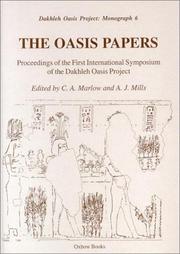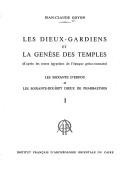| Listing 1 - 10 of 564 | << page >> |
Sort by
|
Book
ISBN: 9782910173494 Year: 2017 Publisher: Orléans [Musée des beaux-arts]
Abstract | Keywords | Export | Availability | Bookmark
 Loading...
Loading...Choose an application
- Reference Manager
- EndNote
- RefWorks (Direct export to RefWorks)


ISBN: 1900188546 Year: 2001 Publisher: Oxford Oxbow
Abstract | Keywords | Export | Availability | Bookmark
 Loading...
Loading...Choose an application
- Reference Manager
- EndNote
- RefWorks (Direct export to RefWorks)
Fouilles archéologiques --- Dakhla (Égypte ; oasis) --- Égypte --- Dakhla (Égypte ; oasis) --- Antiquités
Book
ISSN: 16135628 ISBN: 9783447060936 Year: 2010 Volume: 31 Publisher: Wiesbaden Harrassowitz
Abstract | Keywords | Export | Availability | Bookmark
 Loading...
Loading...Choose an application
- Reference Manager
- EndNote
- RefWorks (Direct export to RefWorks)
Papyrus grecs --- Papyrus coptes --- Égypte
Book
ISBN: 9782916142302 2916142304 Year: 2023 Publisher: Montpellier : Paris : ©2023 Université Paul-Valéry Montpellier 3 ; Editions Khéops.
Abstract | Keywords | Export | Availability | Bookmark
 Loading...
Loading...Choose an application
- Reference Manager
- EndNote
- RefWorks (Direct export to RefWorks)
Claude Traunecker, qui fête ses quatre-vingts ans, a longuement arpenté la région thébaine durant sa carrière. L'homme des temples - tels Karnak (où il a vécu et œuvré seize années), Coptos, el-Q'ala, Chenhour ou le Qasr el-Agoûz - tente depuis quelques années de résoudre les énigmes de la célèbre tombe de Padiaménopé. L'archéologue, spécialiste des cryptes, des ouâbets ou des chenâ-ouâb, est également philologue et musicien. L'historien des époques tardives, qui s'est rapidement imposé comme l'un des meilleurs connaisseurs de la période amarnienne, est aussi un spécialiste de la religion égyptienne, expert ès prêtrises et rites thébains, et inventeur de la « théologie pariétale » ou des » rites de substitution ». Maniant avec une égale aisance les ressources de la chimie comme celles de la physique, il sait comme nul autre les mettre à profit pour étudier une collection d'objets ou les pierres d'un temple. Ce spécialiste des matériaux, enfin, sait être chercheur aussi bien qu'enseignant. Ce volume rassemble les contributions que ses collègues, amis, anciens élèves et proches ont voulu lui dédier en témoignage de leur amitié et de leur admiration pour son immense contribution à l'égyptologie. Il présente trente-cinq articles scientifiques et des réflexions relevant d'un registre plus personnel : des témoignages inédits sur la vie d'un savant qui fut aussi un aventurier spéléologue- et pas seulement dans les souterrains de la tombe de Padiaménopé (TT 33).
Book
ISBN: 9782724705232 Year: 1963 Publisher: Le Caire Institut français d'archeologie orientale
Abstract | Keywords | Export | Availability | Bookmark
 Loading...
Loading...Choose an application
- Reference Manager
- EndNote
- RefWorks (Direct export to RefWorks)
Esnèh (égypte) --- Inscriptions hiéroglyphiques --- Égyptien ancien (langue) --- Temple de khnoum --- Égypte --- Esnèh (égypte) --- Écriture hiéroglyphique
Book
ISBN: 9062582141 Year: 2000 Publisher: Leiden Nederlands instituut voor het Nabije Oosten
Abstract | Keywords | Export | Availability | Bookmark
 Loading...
Loading...Choose an application
- Reference Manager
- EndNote
- RefWorks (Direct export to RefWorks)
Tombes --- Papyrus égyptiens --- Égypte --- Thèbes (ville ancienne)
Book
ISBN: 9783830021810 383002181X Year: 2006 Publisher: Hamburg Kovač
Abstract | Keywords | Export | Availability | Bookmark
 Loading...
Loading...Choose an application
- Reference Manager
- EndNote
- RefWorks (Direct export to RefWorks)
Constructions troglodytiques --- Spéos --- Inscriptions égyptiennes --- Temples égyptiens --- Abou Oda (Égypte ; site archéologique). --- Égypte

ISBN: 2724700171 2724700163 2724700155 9782724700169 9782724700176 Year: 1985 Volume: 93/1-2 Publisher: Le Caire Institut français d'archéologie orientale du Caire
Abstract | Keywords | Export | Availability | Bookmark
 Loading...
Loading...Choose an application
- Reference Manager
- EndNote
- RefWorks (Direct export to RefWorks)
Mythology, Egyptian --- Temples --- Egypt --- Religion --- Mythology, Egyptian. --- Religion. --- Temples - Egypt --- Egypt - Religion --- Dieux égyptiens --- Edfou (Égypte) --- Horbeit (Égypte) --- Culte --- Égypte --- Temple d'Horus --- Antiquités
Book

ISBN: 9782724707687 2724707680 Year: 2021 Publisher: Le Caire Institut français d'archéologie orientale
Abstract | Keywords | Export | Availability | Bookmark
 Loading...
Loading...Choose an application
- Reference Manager
- EndNote
- RefWorks (Direct export to RefWorks)
In the area of Balat on the eastern Dakhla Oasis the archaeological mission of the French Institute for Oriental Archaelogy has uncovered a large area consisting of various camps dating from the early 4th Dynasty (ca. 2600 BC), which were briefly but intensively occupied. These are understood to have served as residential base camps for some of the indigenous (and not yet fully sedentary) population of the oasis, the so-called Late Sheikh Muftah group. Little is known about this rather enigmatic group, but the excavations at Balat have revealed for the first time a well-preserved intra-site stratigraphy with hitherto unknown dwelling features for Sheikh Muftah contexts. The data gathered here is based on analysis of the features, the material culture and in-depth scientific studies. The new evidence offers not only hints about local crafts, food production and environmental conditions in Balat, but also represents a new contribution to ongoing discussions on subsistence and patterns of mobility of non-sedentary groups in the Western Desert. This has given archaeologists a glimpse of the lifestyle of the Sheikh Muftah group, and also, for the first time, shone a spotlight on daily life in a camp site in the oasis depression. The date of this occupation in the Early Old Kingdom falls into a period when Egyptian Pharaonic presence was just beginning to be evident in archaeological data. Cross-cultural contacts between the Balat Sheikh Muftah community and the Egyptian Pharaonic population, both within the oasis and into the Nile Valley are also in evidence and contribute to the discussions on transcultural exchange and assimilation processes in the oasis. Au nord des enceintes pharaoniques d'Ayn Asil à Balat, sur le bord oriental de l'oasis de Dakhla, la mission archéologique de l'Institut français d'archéologie orientale a mis au jour un site étendu, datant de la IVe dynastie (ca. 2600 BC), composé de différents campements individuels. Ces campements n'étaient pas des campements de longue durée, mais ils furent occupés de manière régulière et soutenue. Il semble qu'ils aient servi de camps de résidence temporaire pour une partie de la population indigène (pas encore totalement sédentarisée) de l'oasis, le groupe dit « Sheikh Moftah tardif ». On sait peu de choses sur ce groupe, mais les travaux à Balat ont révélé pour la première fois une séquence stratigraphique bien préservée et des structures d'habitation, jusque-là inconnues pour ce groupe. Les études rassemblées dans ce livre consistent en l'analyse des structures, la présentation de la culture matérielle et l'expose of mobility of non-sedentary groups in the Western Desert. This has given archaeologists a glimpse of the lifestyle of the Sheikh Muftah group, and also, for the first time, shone a spotlight on daily life in a camp site in the oasis depression. The date of this occupation in the Early Old Kingdom falls into a period when Egyptian Pharaonic presence was just beginning to be evident in archaeological data. Cross-cultural contacts between the Balat Sheikh Muftah community and the Egyptian Pharaonic population, both within the oasis and into the Nile Valley are also in evidence and contribute to the discussions on transcultural exchange and assimilation processes in the oasis. ́ des résultats des analyses archéométriques. Les données recueillies fournissent des informations sur les travaux artisanaux, la production de nourriture et les conditions de vie à Balat. Elles apportent une contribution précieuse aux discussions scientifiques sur les moyens de subsistance et la mobilité des communautés non permanentes dans le désert occidental. Les archéologues peuvent ainsi se faire une idée de la vie du groupe Sheikh Moftah et, de manière plus générale, de la vie quotidienne dans un campement au sein de l'oasis. La datation de cette occupation du site au début de l'Ancien Empire correspond à une période pour laquelle les données archéologiques rendent de plus en plus évidente la présence égyptienne pharaonique dans l'oasis. Les contacts sont certains entre la communauté Sheikh Moftah à Balat et la population égyptienne pharaonique, à la fois dans la Vallée du Nil et dans l'oasis, et permettent de nourrir la dislity of non-sedentary groups in the Western Desert. This has given archaeologists a glimpse of the lifestyle of the Sheikh Muftah group, and also, for the first time, shone a spotlight on daily life in a camp site in the oasis depression. The date of this occupation in the Early Old Kingdom falls into a period when Egyptian Pharaonic presence was just beginning to be evident in archaeological data. Cross-cultural contacts between the Balat Sheikh Muftah community and the Egyptian Pharaonic population, both within the oasis and into the Nile Valley are also in evidence and contribute to the discussions on transcultural exchange and assimilation processes in the oasis. cussion sur les échanges transculturels et les processus d'assimilation dans l'oasis.
Fouilles archéologiques --- Balāṭ (Égypte ; site archéologique). --- Dakhla (Égypte ; oasis). --- Égypte --- Fouilles archéologiques --- Balāṭ (Égypte ; site archéologique) --- Dakhla (Égypte ; oasis) --- Égypte --- Excavations (Archaeology) --- Material culture --- Human settlements --- Egypt --- History
Book
ISBN: 3901232680 Year: 2006 Publisher: Wien Phoibos-Verlag
Abstract | Keywords | Export | Availability | Bookmark
 Loading...
Loading...Choose an application
- Reference Manager
- EndNote
- RefWorks (Direct export to RefWorks)
Rites et cérémonies --- Rites et cérémonies --- Archéologie et religion --- Archéologie et religion --- Grèce --- Antiquité --- Égypte --- Antiquité --- Grèce --- Égypte
| Listing 1 - 10 of 564 | << page >> |
Sort by
|

 Search
Search Feedback
Feedback About
About Help
Help News
News